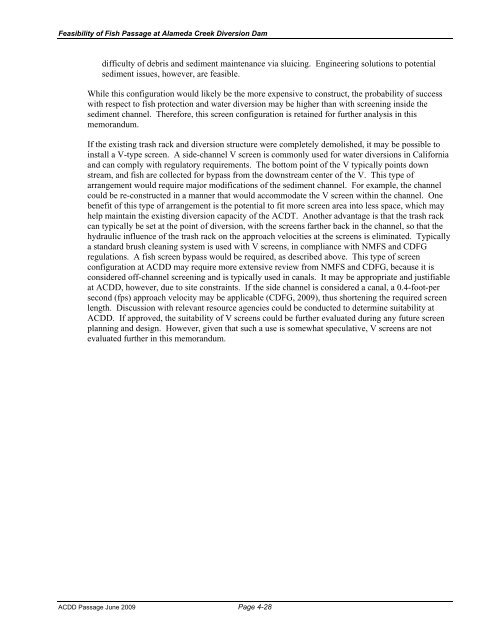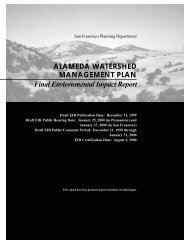<strong>Feasibility</strong> <strong>of</strong> <strong>Fish</strong> <strong>Passage</strong> <strong>at</strong> <strong>Alameda</strong> <strong>Creek</strong> <strong>Diversion</strong> <strong>Dam</strong>difficulty <strong>of</strong> debris and sediment maintenance via sluicing. Engineering solutions to potentialsediment issues, however, are feasible.While this configur<strong>at</strong>ion would likely be the more expensive to construct, the probability <strong>of</strong> successwith respect to fish protection and w<strong>at</strong>er diversion may be higher than with screening inside thesediment channel. Therefore, this screen configur<strong>at</strong>ion is retained for further analysis in thismemorandum.If the existing trash rack and diversion structure were completely demolished, it may be possible toinstall a V-type screen. A side-channel V screen is commonly used for w<strong>at</strong>er diversions in Californiaand can comply with regul<strong>at</strong>ory requirements. The bottom point <strong>of</strong> the V typically points downstream, and fish are collected for bypass from the downstream center <strong>of</strong> the V. This type <strong>of</strong>arrangement would require major modific<strong>at</strong>ions <strong>of</strong> the sediment channel. For example, the channelcould be re-constructed in a manner th<strong>at</strong> would accommod<strong>at</strong>e the V screen within the channel. Onebenefit <strong>of</strong> this type <strong>of</strong> arrangement is the potential to fit more screen area into less space, which mayhelp maintain the existing diversion capacity <strong>of</strong> the ACDT. Another advantage is th<strong>at</strong> the trash rackcan typically be set <strong>at</strong> the point <strong>of</strong> diversion, with the screens farther back in the channel, so th<strong>at</strong> thehydraulic influence <strong>of</strong> the trash rack on the approach velocities <strong>at</strong> the screens is elimin<strong>at</strong>ed. Typicallya standard brush cleaning system is used with V screens, in compliance with NMFS and CDFGregul<strong>at</strong>ions. A fish screen bypass would be required, as described above. This type <strong>of</strong> screenconfigur<strong>at</strong>ion <strong>at</strong> ACDD may require more extensive review from NMFS and CDFG, because it isconsidered <strong>of</strong>f-channel screening and is typically used in canals. It may be appropri<strong>at</strong>e and justifiable<strong>at</strong> ACDD, however, due to site constraints. If the side channel is considered a canal, a 0.4-foot-persecond (fps) approach velocity may be applicable (CDFG, 2009), thus shortening the required screenlength. Discussion with relevant resource agencies could be conducted to determine suitability <strong>at</strong>ACDD. If approved, the suitability <strong>of</strong> V screens could be further evalu<strong>at</strong>ed during any future screenplanning and design. However, given th<strong>at</strong> such a use is somewh<strong>at</strong> specul<strong>at</strong>ive, V screens are notevalu<strong>at</strong>ed further in this memorandum.ACDD <strong>Passage</strong> June 2009 Page 4-28
5.0 Capital and Oper<strong>at</strong>ing and Maintenance Costs5 CAPITAL AND OPERATING AND MAINTENANCE COSTSIn the previous section, design components were identified and evalu<strong>at</strong>ed based on their ability tomeet the biological requirements <strong>of</strong> adult steelhead immigr<strong>at</strong>ion, and screened for suitability <strong>at</strong>ACDD. The design components evalu<strong>at</strong>ed in this section were retained for further consider<strong>at</strong>ionbecause they are more likely to meet the biological requirements <strong>of</strong> passage and are considered to begenerally suitable for this loc<strong>at</strong>ion. In cases where multiple vari<strong>at</strong>ions <strong>of</strong> a design component couldpotentially be suitable <strong>at</strong> ACDD, an effort was made to select the design component th<strong>at</strong> appearedmost favorable, based on potential cost, biological suitability, and engineering feasibility, and onlycarry forward th<strong>at</strong> design component. The following design components were retained through thepreliminary analysis, and are evalu<strong>at</strong>ed in this section based on cost:■■■<strong>Fish</strong> ladderTrap and haul<strong>Fish</strong> screensThe estim<strong>at</strong>ed cost <strong>of</strong> fish passage, including screening, is presented in the following sections based oncapital costs <strong>of</strong> construction (Section 5.1), estim<strong>at</strong>ed cost <strong>of</strong> lost w<strong>at</strong>er diversion opportunitiesassoci<strong>at</strong>ed with fish ladders and screening (Section 5.2), and the total annualized cost <strong>of</strong> each designcomponent alone and in combin<strong>at</strong>ions th<strong>at</strong> together provide complete fish passage options (Section 5.3).5.1 CAPITAL COSTSThe cost <strong>of</strong> passage and screening design components <strong>at</strong> the ACDD includes both the capital cost <strong>of</strong>constructing the facilities and annual oper<strong>at</strong>ions and maintenance costs. This section describes theestim<strong>at</strong>ed capital costs associ<strong>at</strong>ed with the design components retained through the initial analysis.Capital cost estim<strong>at</strong>es are provided based upon facilities <strong>at</strong> other sites where similar projects have beenimplemented, as well as typical industry costs and engineering judgment. Each design component wasevalu<strong>at</strong>ed on a conceptual level, taking into consider<strong>at</strong>ion basic factors such as site conditions andconceptual designs. When sufficient inform<strong>at</strong>ion was available, capital costs for the design componentswere estim<strong>at</strong>ed by developing unit costs and multiplying these by estim<strong>at</strong>ed quantities. Unit costs werecompared with historical d<strong>at</strong>abase unit prices; vendor quotes were used, when available. Where thelevel <strong>of</strong> design detail was insufficient to support an estim<strong>at</strong>e, lump sum allowances based on historicalexperience for similar projects were used. Raw capital costs were then gener<strong>at</strong>ed for each designcomponent. Estim<strong>at</strong>ed raw costs and additional assumptions are detailed in Appendix A.As described in Section 4, the Long <strong>Fish</strong>way and the screen configur<strong>at</strong>ion outside <strong>of</strong> the sedimentchannel have been carried forward in this memorandum. Comprehensive design work has not beendone for any <strong>of</strong> the design components. For purposes <strong>of</strong> analysis, rel<strong>at</strong>ive cost estim<strong>at</strong>es weredeveloped. Raw capital costs presented in Table 5-1 are based on the limited descriptions <strong>of</strong> thedesign components provided in Section 4 and assumptions regarding the types <strong>of</strong> m<strong>at</strong>erials presentedin Appendix A.The SFPUC W<strong>at</strong>er System Improvement Program (WSIP) program delivery cost methodology(SFPUC, 2006) was used to determine the factor to add to the raw construction cost to develop a totalestim<strong>at</strong>ed capital cost for each design component (Table 5-1). The total factor <strong>of</strong> 100 percent consists<strong>of</strong> an estim<strong>at</strong>e contingency (25 percent), construction escal<strong>at</strong>ion to time <strong>of</strong> construction (24 percent),construction contingency (10 percent), and s<strong>of</strong>t costs (e.g., planning, design, review, management, etc.)(41 percent).ACDD <strong>Passage</strong> June 2009 Page 5-1








